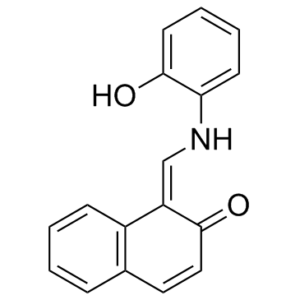HAMNO (NSC111847)
This product is for research use only, not for human use. We do not sell to patients.

For small sizes, please check our retail website as below: www.invivochem.com
| Size | Price | Stock |
|---|---|---|
| 250mg | $450 | Check With Us |
| 500mg | $750 | Check With Us |
| 1g | $1125 | Check With Us |
Cat #: V3221 CAS #: 138736-73-9 Purity ≥ 98%
Description: HAMNO (formerly known as NSC-111847) is a novel, potent and selective protein interaction inhibitor of replication protein A (RPA).
Top Publications Citing Invivochem Products
Publications Citing InvivoChem Products
Product Promise

- Physicochemical and Storage Information
- Protocol
- Related Biological Data
- Stock Solution Preparation
- Quality Control Documentation
| Molecular Weight (MW) | 263.30 |
|---|---|
| Molecular Formula | C17H13NO2 |
| CAS No. | 138736-73-9 |
| Storage | -20℃ for 3 years in powder formr |
| -80℃ for 2 years in solvent | |
| Solubility In Vitro | DMSO: >150 mg/mLr |
| Water: < 0.1 mg/mL (insoluble)r | |
| Ethanol: N/A | |
| SMILES Code | O=C(C=CC1=C/2C=CC=C1)C2=C/NC3=CC=CC=C3O |
| Synonyms | CID 6335338, MLS000737724, NSC 111847, NSC111847; NSC-111847; HAMNO |
| Protocol | In Vitro | HAMNO is a novel protein interaction inhibitor of replication protein A (RPA). RPA is involved in the ATR/Chk1 pathway. HAMNO alone inhibits colony formation in both HNSCC cell lines in the low micromolar range. HAMNO combined with etoposide significantly inhibits colony formation to a greater degree than HAMNO alone. After UMSCC38 cells are exposed to HAMNO, increased pan-nuclear γ-H2AX staining occurs in a dose dependent manner. Cancer derived UMSCC38 cells, as well as another cancer cell line, UMSCC11B, have prominent γ-H2AX staining, particularly after incubation with 20 μM HAMNO. Both UMSCC38 and OKF4 cells present increased γ-H2AX staining after addition of HAMNO, with the greatest increase in signal occurring in S-phase. |
|---|---|---|
| In Vivo | In mice, HAMNO slows the progression of UMSCC11B tumors. Ser33 of RPA32, an ATR substrate, is highly phosphorylated after two hours of treatment with 20 μM of etoposide, which is reduced with the addition of 2 μM HAMNO, and is nearly absent at higher concentrations, demonstrating an in vivo effect of HAMNO as an inhibitor of RPA32 phosphorylation by ATR. |
These protocols are for reference only. InvivoChem does not
independently validate these methods.
| Solvent volume to be added | Mass (the weight of a compound) | |||
|---|---|---|---|---|
| Mother liquor concentration | 1mg | 5mg | 10mg | 20mg |
| 1mM | 3.7979 mL | 18.9897 mL | 37.9795 mL | 75.9590 mL |
| 5mM | 0.7596 mL | 3.7979 mL | 7.5959 mL | 15.1918 mL |
| 10mM | 0.3798 mL | 1.8990 mL | 3.7979 mL | 7.5959 mL |
| 20mM | 0.1899 mL | 0.9495 mL | 1.8990 mL | 3.7979 mL |
The molarity calculator equation
Mass(g) = Concentration(mol/L) × Volume(L) × Molecular Weight(g/mol)
Mass
=
Concentration
×
Volume
×
Molecular Weight*
The dilution calculator equation
Concentration(start)
×
Volume(start)
=
Concentration(final)
×
Volume(final)
This equation is commonly abbreviated as: C1 V1 = C2 V2
Concentration(start)
C1
×
Volume(start)
V1
=
Concentration(final)
C2
×
Volume(final)
V2
Step One: Enter information below
Dosage mg/kg
Average weight of animals g
Dosing volume per animal µL
Number of animals
Step Two: Enter the in vivo formulation
%DMSO
+
%
+
%Tween 80
+
%ddH2O
Calculation Results:
Working concentration:
mg/ml;
Method for preparing DMSO master liquid:
mg
drug pre-dissolved in
µL
DMSO(Master liquid concentration
mg/mL)
,Please contact us first if the concentration exceeds the DMSO solubility of the batch of drug.
Method for preparing in vivo formulation:
Take
µL
DMSO master liquid, next add
µL
PEG300, mix and clarify, next add
µL
Tween 80,mix and clarify, next add
µL
ddH2O,mix and clarify.
Note:
- (1) Please be sure that the solution is clear before the addition of next solvent. Dissolution methods like vortex, ultrasound or warming and heat may be used to aid dissolving.
- (2) Be sure to add the solvent(s) in order.




































